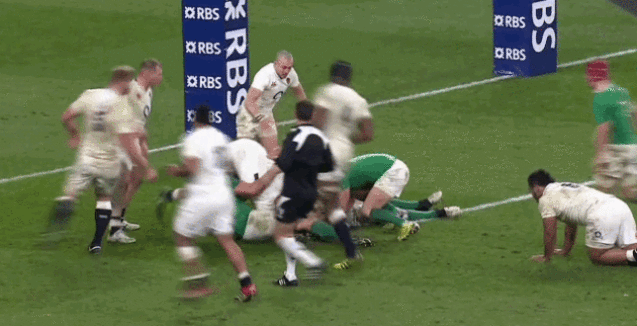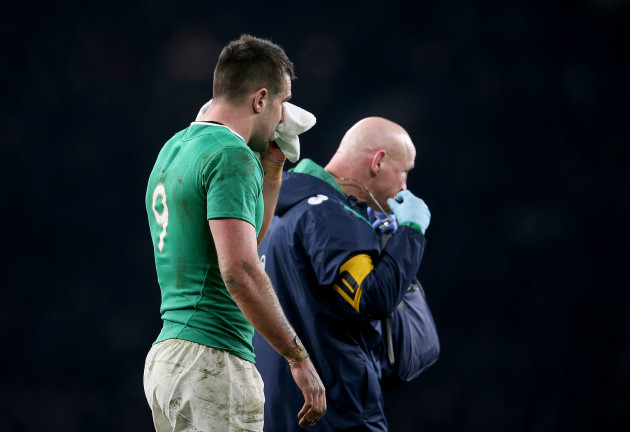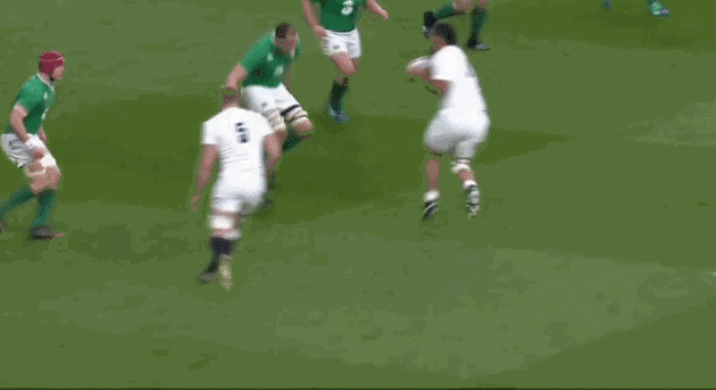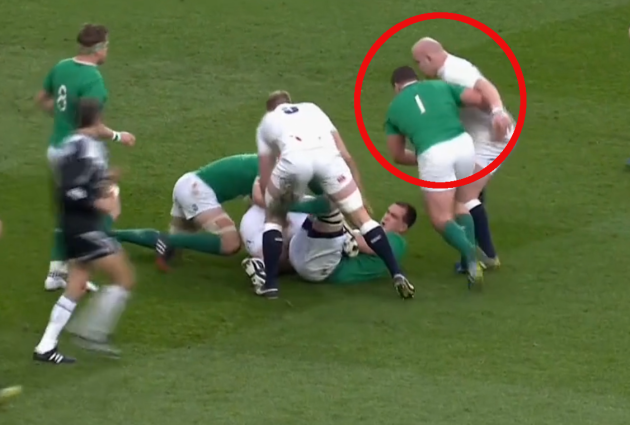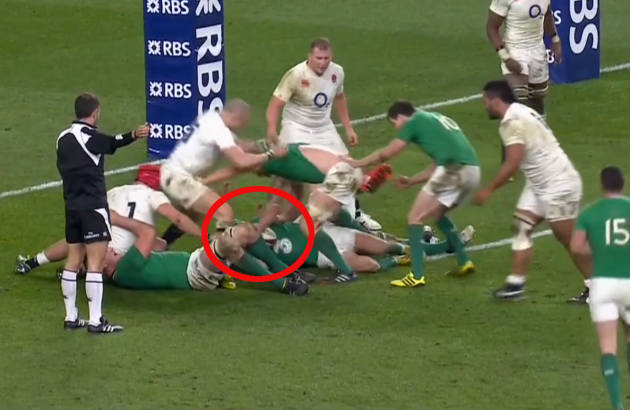MIKE BROWN WAS at the centre of a controversial incident during England’s 21-10 win over Ireland in the Six Nations on Saturday.
Many were expecting the England fullback to be cited for what has widely been perceived as a reckless use of the boot in making contact with the face of Conor Murray at a ruck close to the English tryline late in the game, but the Six Nations has confirmed Brown will not face a disciplinary hearing.
Referee Romain Poite and television match official Shaun Veldsman felt Brown’s connection with the face of the Ireland scrum-half was accidental at the time and Joe Schmidt echoed that sentiment after the game.
Kicking an opponent in the face, or anywhere on the body, is obviously outlawed in rugby and though Brown doesn’t appear to deliberately make contact with Murray’s face here, many viewed his actions as reckless, i.e. that Brown knew [or should have known] there was a risk of committing an act of foul play.
While the Brown case is now closed, kicking the ball out of the ruck has been a contentious issue within the game for much longer than the last two days. Many high-level coaches are against the action, which is entirely legal under World Rugby’s current laws.
“Players are rucking when they are in a ruck and using their feet to try to win or keep possession of the ball, without being guilty of foul play,” states the definition of a ruck in the game’s lawbook.
The other references to use of the feet in a ruck say players must not “pick up the ball in a ruck with their legs,” an offence that is sanctionable with a penalty, and that a player cannot intentionally ruck a player on the ground.
The Brown incident has already been argued over extensively, but our focus here is on the actual act of kicking the ball out of a ruck.
England have been excellent in this area under Jones so far in the Six Nations, consistently dislodging the ball through the back-end of rucks, or at least slowing the opposition scrum-half’s attempts to pass the ball away.
Clearly this is a focused part of their defensive strategy, but they are certainly not the only team who look to kick balls loose after the tackle.
Below, we see Josh van der Flier doing it for Ireland in the first half at Twickenham.
It’s classic openside play and many Ireland fans would have applauded the use of the boot at this point. It is, of course, a very different situation to the one involving Brown later in the game.
Firstly, the ball is further away from the face of the player on the ground, with Billy Vunipola getting a full extension of the arms in placing it back on England’s side.
Van der Flier benefits from the intelligent work of Jack McGrath on his left, the loosehead prop taking potential ruck arriver Dan Cole out of the game off the ball.
With Toner on the ground at the front of the tackle, George Kruis cannot get ideal access either, meaning van der Flier can fight up to his feet and plant his left leg near the ball, to kick with his right just as Kruis engages with him to form what would be a ruck.
It’s a lot cleaner than the Brown incident, particularly because it’s more of a breakdown situation for van der Flier to arrive into, rather than the ruck that Brown is presented with.
This is good, smart play from van der Flier and he is entirely within the laws of the game to do so.
That’s the underlying point here; rugby players would be foolish not to attempt to kick the ball out of rucks if they are in any position to do so. It’s legal and it ruins the opposition’s possession.
If the ball comes loose on Brown’s first dab at the ball, that is smart play. Instead, Murray’s knee and hands ensure that he retains ‘possession’ and with van der Flier taking a split second to decide to clear the England fullback out, Brown kicks at out the ball again.
As van der Flier eventually does start to drive Brown back, the Harlequins man has another two swings at the ball, this time with his right foot. The ball is now up on Murray’s chest, after he rolls backward from the blow to his face with the heel of Brown’s left boot on his third dab at it.
Watching the incident again, it does seem crazy that Brown is entitled to attempt to kick at the ball here, but so allows the laws of the game, as long as the officials feel he is not being reckless in his actions.
It’s the actual lawbook where Schmidt has an issue. The Ireland head coach feels that a rucking action should not leave his scrum-half needing stitches beside his eye.
“I’m not going to chase those things,” said Schmidt post-match. “They’re decisions that officials make and they make them under pressure and they have other people look at things. I’ve never chased one of those and I won’t start now.
“The one thing that I did identify is it is something that appears to be a strategy. There is a lot of kicking the ball out of the ruck and I just think it’s probably something that even the lawmakers or the officials have to have a bit of a look at just regarding player safety, particularly with the head and particularly the eyes as it was in this incident.”
It’s hard to argue with Schmidt’s assertion after an incident like this one. One for World Rugby to take a close look at.
